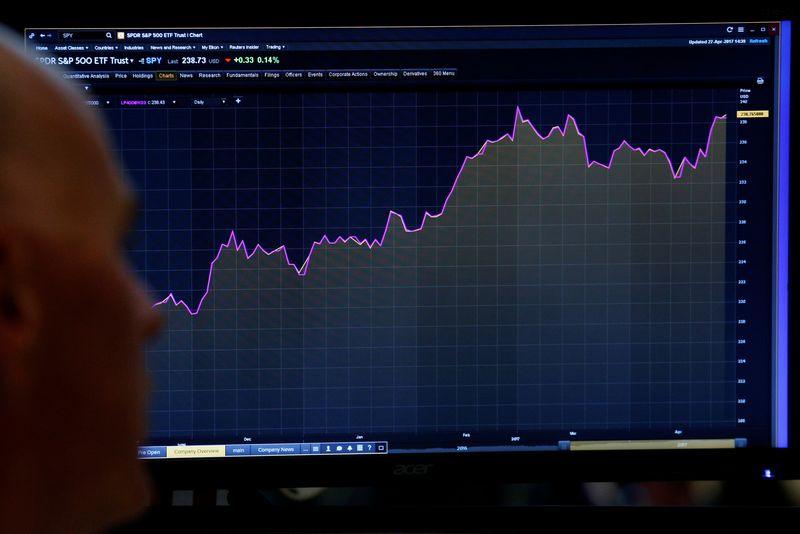
© Reuters. FILE PHOTO: A trader looks at a screen that charts the S&P 500 on the floor of the New York Stock Exchange (NYSE) in New York, U.S., April 27, 2017. REUTERS/Brendan McDermid
By Patturaja Murugaboopathy and Chuck Mikolajczak
(Reuters) – U.S. dividend funds have faced steep outflows this year after strong inflows last year as investors rush to safer money market funds and bank deposits, providing high returns without much risk.
Interest rates on short-tenor bonds have risen this year on expectations that the U.S. Federal Reserve would continue to hike interest rates to combat inflation pressures, after raising them seven times in the last year.
According to Refinitiv data, U.S. dividend funds witnessed an outflow of $5.6 billion in the first quarter of this year, the first in 10 quarters.
On the other hand, U.S. money market funds secured a massive $391.5 billion inflow in the first quarter, the biggest in three years.
“The yields on money market funds became much more attractive after investors received their December 2022 statements in January of this year and saw that even their dividend paying stocks were down quite a bit while money market funds at that point were seeing yields near 4+,” said Ayako Yoshioka, senior portfolio manager at Wealth Enhancement Group.
“As long as the stability and income generated from money market funds remain attractive relative to stocks, the outflows may continue this year.”
GRAPHIC: Money flows into US dividend funds
The yield on the 3-month U.S. Treasury bill, in which money market funds invest the most, touched 5.061% on March 9, near a 16-year high, and was currently trading at about 4.8%. That compares with the large and mid-cap U.S. companies’ average dividend yield of just 1.8%, according to Refinitiv data
GRAPHIC: dividend yield vs 3-month U.S Treasury bill
Also, the underperformance of the financial and energy sectors, down about 6% each during the first quarter and are major sources of dividends to U.S. investors, has contributed to the steep outflows over the first three months of 2023.
Josh Duitz, deputy head of global equities at Abrdn, said investors have been selling dividend funds as they chased stocks in the , which outperformed in the first quarter, but they tend to pay low or no dividends.
In the first quarter, the iShares Core High Dividend ETF saw an outflow of $1.77 billion, while Vanguard Dividend Appreciation Index ETF and TD U.S. Blue Chip Equity Investor Series fund witnessed $1.02 billion and $645 million worth of withdrawals, respectively.
However, some analysts said dividend funds are still the safer option as they invest in companies with solid balance sheets and healthy cash flows which are likely to be more resilient during an economic slowdown.
“Though we have experienced periods where the capital appreciation of a stock’s price has dwarfed the return from dividend income, the power of dividends should not be overlooked as a crucial component of equity performance,” said Christopher Huemmer, senior vice president at FlexShares Exchange Traded Funds.
“In volatile markets, dividends can act like the keel of a sailboat, providing a level of stable return in choppy seas.”





